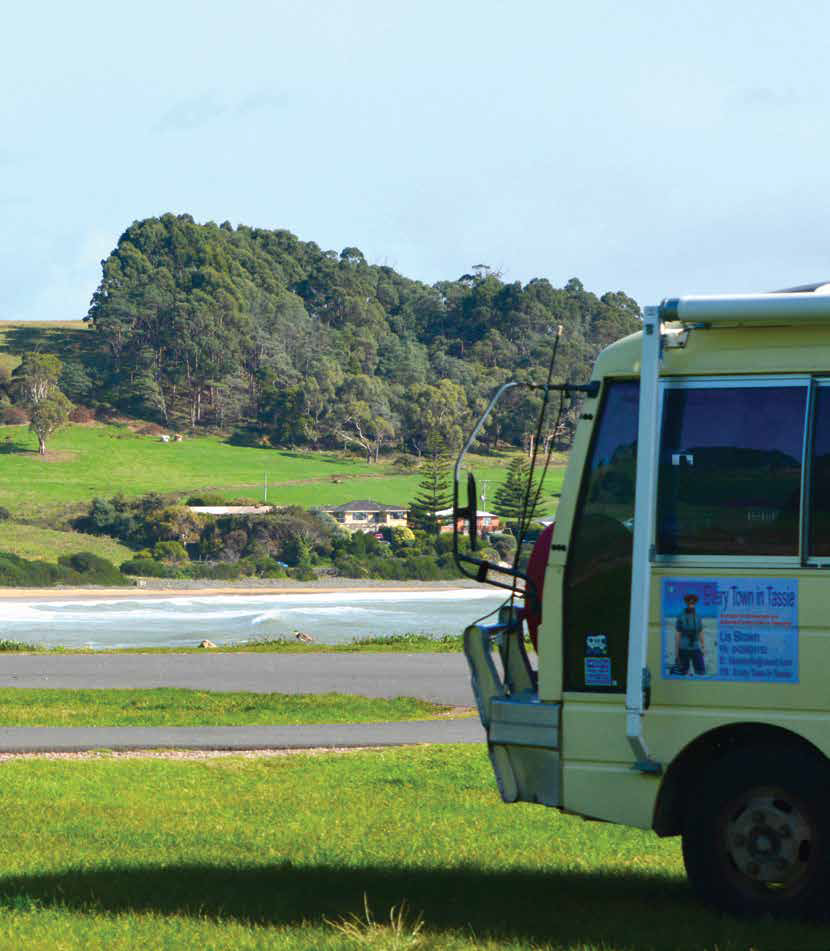
Travelling Launceston to Burnie in April 2018 took a leisurely 31 days, 534 kilometres, and included 17 campsites.
As my CMCA friends Gerard and Duky Rutten were returning to the mainland, I planned a trip around meeting them at Forth, a small village in north-west Tasmania on the Forth River, before their departure.
From Launceston, the first stop would normally be Entally House at Hadspen, but having visited the historic homestead and gardens before, I decided upon one of my favourite spots, the lovely village of Carrick. A must-visit when in Carrick is the Tasmanian Metal and Copper Art Gallery, where Tom and Gail Merrick operate this longstanding family concern alongside the historic trust ruins of Archer’s Folly, which originally housed the gallery before it burnt almost to the ground in 1978.
Note: Hadspen has two caravan parks. Discovery and Big4. There are no solo rates. There’s no free camping option, but there is good parking at the Lions Park on the banks of the South Esk River. In Carrick, there’s no caravan parks or free camping but, again, there is good drive-through parking behind the Carrick Town Hall.
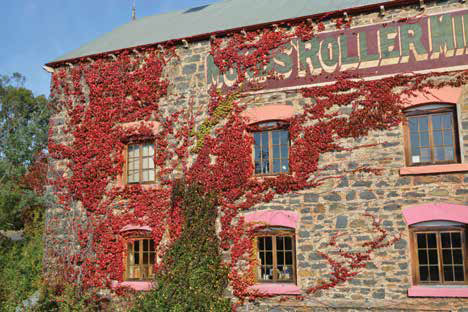
A must-visit when in Carrick is the Tasmanian Metal and Copper Art Gallery
DELIGHTFUL DELORAINE
The trek to Deloraine winds through the Meander Valley Shire, which closed its four free camps in April. They may re-open, perhaps with the permit system now operating elsewhere for self-contained vehicles. The back road led us through the scenic Whitemore, Oaks, and Osmaston areas. These are small communities with no services to speak of due to their proximity to Deloraine.
Calling in on a friend at Golden Valley, I explored the small low-cost caravan park at Quamby Corner. Fees apply and there are solo rates available. It’s particularly good value when you consider hot showers, and access to washing machines and dryers, is included.
At this point I was only 19km away from Deloraine but decided, due to recent rains, to detour for a look at Liffey Falls - a favourite spot of mine. The last few kilometres are not appreciated by big rigs due to a narrow and winding road, but my seven metre Nissan bus had no problems. The 20 minute walk to the falls is well-graded and a no dog zone, so my tribe dutifully stayed at home. On the way down, the track runs alongside the cascades for about 200m, and on reaching the bottom I was rewarded with spectacular, multi-level falls. Thanks to the rain, the water ran and dropped cleanly to a pool before cascading downstream.
Deloraine is a popular stopover. The Deloraine Apex Caravan Park is invitingly placed by the river and within walking distance of town. Free camping is currently suspended in Deloraine but the dump point remains open.
Deloraine has much to offer. It is a Woolworths/Coles town, and I tend to measure the size of a town by their grocery shopping options. Hats off to IGA in my book too, for their store numbers and locations. Tassie has 14 IGAs run by Hill Street Grocers, who are an entity unto themselves and superior to anything I’ve come across anywhere. They’re a great place to stock up on arrival in Devonport.
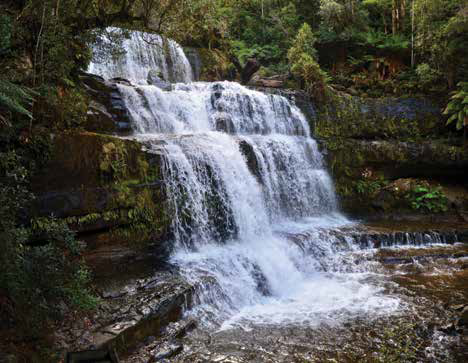
Liffey Falls, a series of four distinct tiered–cascade waterfalls on the Liffey River
Back to Deloraine. It’s home to a 50s diner, lots of alfresco dining and coffee shops along the main street, at least two pubs, and an excellent museum at the visitor centre which also houses the must see ‘Yarns’, which is often mistakenly called a tapestry. It is all handcrafted from various yarns. Ten years and 300 people in the making/stitching, it stretches across the front of a theatrette and will have you spellbound.
In November, Deloraine is host to the four day Tasmanian Arts and Craft Fair, which is the largest such fair in the southern hemisphere. If you are fast, or have wings on your walker, you can see this in a day, but with about eight venues (all indoors) it is best to spread it out to at least two, but preferably three or four days. Everything on show and/or for sale is first class and the whole operation is well practiced, there’s even a free courtesy bus continually looping the show for your convenience. Just when you think you have seen it all, you are sure to be enthralled by something new. There is usually a four day Tasmania Chapter meeting within walking distance of the bus.
HIDDEN GEMS
From Deloraine I headed to Gowrie Park. I met old Frank at Deloraine, a real true blue Aussie. Frank invited me to his property near Mole Creek, where he and his family all still live on adjoining lands. What a great campsite it was for two nights. Hilly, partly forested, partly cleared, and with about 200 ewes and a ram or two, I camped near a recently built ‘old hut’. The hut alone was worth seeing with hand-split shingles throughout, along with a hand-split timbered kitchen and cabinets. All timbers used came from the property, which Frank and his sons built to utilise the breathtaking, panoramic views. Invitations to stay on rural properties in Tasmania are not rare when you meet and greet these friendly and generous country folk.
Backtracking slightly, Chudleigh has low-cost camping right in town, as does the very popular Melita Honey Farm. Don’t let anyone tell you that you cannot take honey back to the big island. It is only in commercial quantities that restrictions apply. The caravan park just outside of Mole Creek is located creekside. Privately owned and operated, it has all the facilities you need and is great value for money.
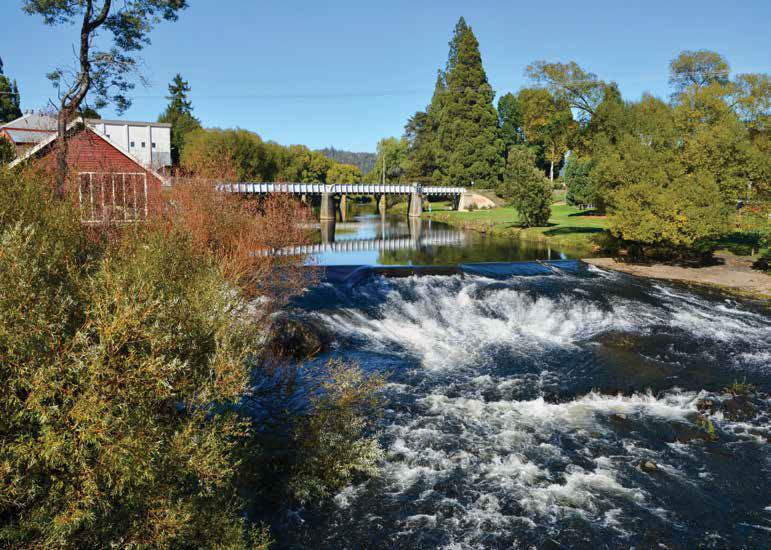
Deloraine, a popular stopover with much to offer including coffee shops and a museum
After Mole Creek I headed for Liena. I had been to Liena on my ‘Every Town in Tassie’ trek but I had not been through Liena as its important, and no doubt old, bridge had been washed away in the then recent 2016 flood. Nothing much at Liena, but the small detour is worth it just for the scenic drive. After rejoining the main road I swung south, to detour back to Lorinna, which is the only town I’d missed in 2016. Lorinna had been isolated by the floods with access only by barge across Lake Cethana. It’s a beautiful dirt road drive, but not one for the faint-hearted and definitely not one for the big rigs or those towing.
After two nights at a scenic spot at Round Mount Lookout, it was time to visit Gowrie Park and check out another great little caravan park, Gowrie Park Wilderness Village. Laundry prices are the same as at Mole Creek, but the hot shower is included in the tariff. For solos, the park offers a rate of $10 for an unpowered site. A 200m walk to the town restaurant netted me a $27 roast lamb dinner and sticky date pudding dessert to die for.
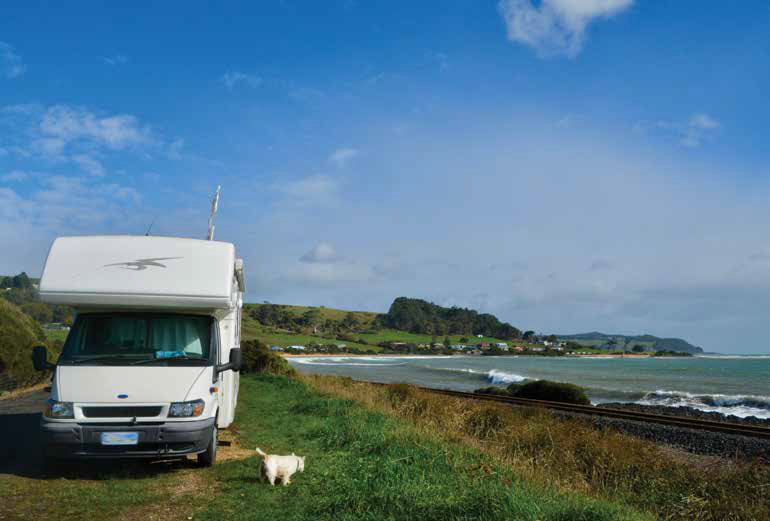
Preservation Bay on the coast line east of Burnie
A FRIENDLY REUNION
With the glorious autumn weather holding fast, I couldn’t count on it lasting, so I quickly closed the gap to Burnie and pulled up with friends at Chasm Creek, just before all hell broke loose with horrendous winds. I laid low for a couple of days, but did visit Guide Falls, around 15km south of Burnie, and was rewarded with yet another fabulous flow and drop. I cannot believe how many people miss Guide Falls. It’s a good spot at the driest of times, has plenty of room for large vehicle parking, and it’s dog friendly. The Makers Workshop is also a must-visit in Burnie. Oodles of big rig parking within 100m of the foreshore.
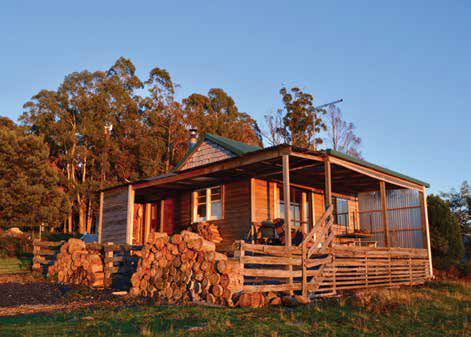
An old hut near Mole Creek
Following the damaging winds and heavy rain were at least three weeks of glorious spring-like weather - and my return to Forth. Sulphur Creek has free camping but does not allow dogs due to the penguin habitat, while Preservation Beach is clear of penguins so dogs are welcome at the free camp there. Penguin, not far from Preservation Beach, is a delight and I struck the local Sunday markets which are indoors and operate all year round. Further on, Ulverstone also has a free camp - small, but right on the river, and within walking distance to town. Duky and Gerard beat me to Forth. With their auxiliary car, we revelled in Devonport’s Hill Street Grocer, and ‘did over’ the Homemakers Centre including Bunnings, Shiploads, Harvey Norman, and more. Shiploads is Tassie’s own ‘cheap shop’ but with a higher quality product. While at Forth, we also ventured back to Penguin (about 22km away) and then to the topiary town of Railton. A farewell dinner at the Forth Pub was in order and it’s always a good value for money affair.
My friends now departed, I swung around and revisited Hawley Beach, Freers Beach at Shearwater, Port Sorrell, and Squeaking Point. This beach-ridden stretch topped by Bass Straight is a popular and high growth area without the free camping. The council-run Port Sorrell Lions Caravan Park is $35 for a powered site, and $25 for an unpowered site with no solo rate.
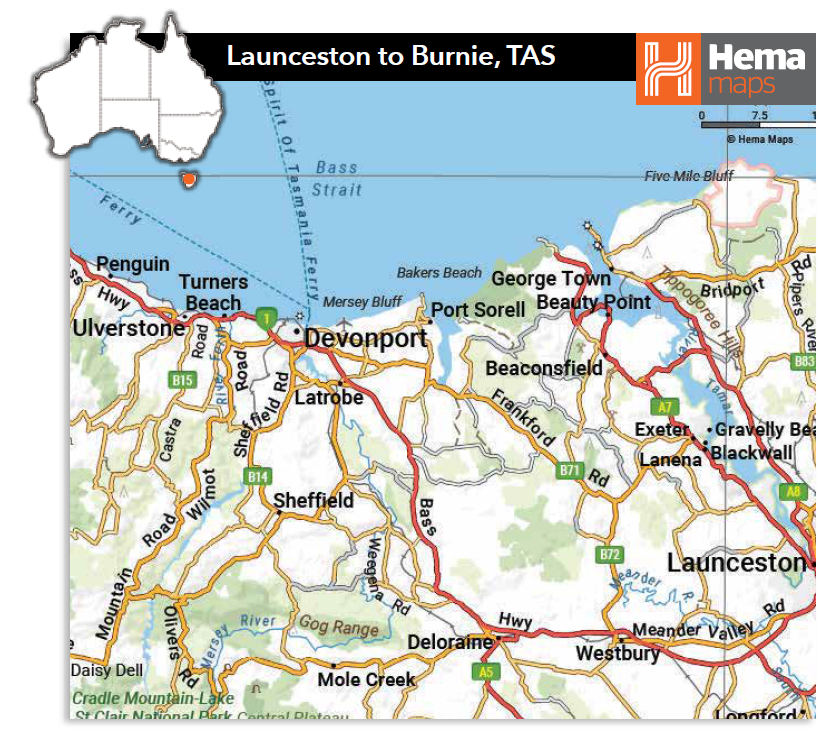
Category: Unknown
Written: Wed 01 Aug 2018
Printed: August, 2018
Published By:
GETTING THERE
As Tasmania’s second largest city, Launceston is easily accessible via regular flights from all major hubs across Australia.
The direct route from Launceston to Burnie, a port city on Tasmania’s north west coast, is 147km long via the National Highway, and takes roughly one hour and 40 minutes. To take a similar journey to Lis, and truly explore the countryside properly, visit the small towns of Deloraine, Mole Creek, and Gowrie Park, and get to know the friendly locals, it’s worth taking your time and stopping at every opportunity.
There are plenty of accommodation options along the way, with many of the caravan parks offering reasonable prices for both powered and unpowered sites.
MORE INFO
To plan your trip to both Launceston,
Burnie, and their surrounds, visit: https://www.discovertasmania.com.au/